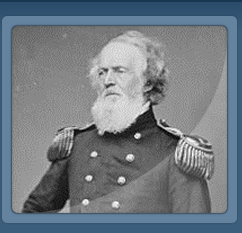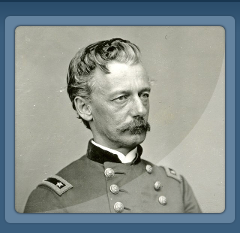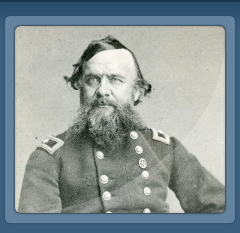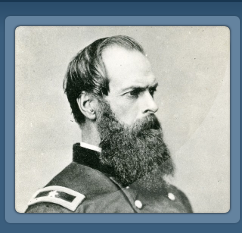Go to Top of Page
Twelfth Corps, from: Regimental Losses in the American Civil War, Chapter VIII, pp. 87-90, by William F. Fox, 1889
Winchester, Port Republic; Cedar Mountain; Manassas; Antietam; Chan-Cellorsville; Gettysburg; Wauhatchie; Lookout Mountain; Missionary Ridge; Ringgold.
The corps that never lost a color or a gun. When its designation was changed to the Twentieth, it still preserved unbroken the same grand record. The veteran divisions of Williams and Geary wore their star-badges through all the bloody battles of the Atlanta campaign and the Carolinas, and still kept their proud claim good, marching northward to the grand review with the same banners that had waved at Antietam and Lookout Mountain -- with the same cannon which had thundered on the battle-fields of seven states.
None were missing.
The organization of the Twelfth Corps may be considered as dating from the General Order of March 13, 1862, under which the corps formation of the Army of the Potomac was first created. By that order, five different corps were constituted, one of which, composed of the divisions of Williams and Shields, and commanded by General Banks, was designated as the Fifth. These divisions were then operating in the Shenandoah Valley. On the 26th of June, the President ordered that "the troops of the Shenandoah Department, now under General Banks, shall constitute the Second Army Corps" of the Army of Virginia. On September 12th, General Order 129, it was ordered that its designation be changed to that of the Twelfth Corps, and that General Joseph K. Mansfield be placed in command.
In the meantime the corps had done considerable hard fighting under its former title. Shields' Division won a brilliant victory over Stonewall Jackson at Kernstown, Va., on the 23d of March, and Williams' Division fought well at Winchester, May 25th, while on Banks' retreat. The battle of Cedar Mountain was also fought by this corps, alone and unassisted; and, although defeated by the overwhelming force of the enemy, the record shows that the two divisions did there some of the best fighting of the War. In that battle the divisions were commanded by Generals Williams and Augur; loss, 302 killed, 1,320 wounded, and 594 missing; total, 2,216, out of less than 6,000 engaged. This loss fell on four brigades, Crawford's Brigade losing 867 men out of 1679, reported by Crawford as "present in engagement." At Manassas the corps was held in reserve.
It participated in the Antietam campaign under its proper designation, as the Twelfth Corps, with the veteran Mansfield in command. Its division and brigade organization was the same as at Cedar Mountain; General George S. Greene had succeeded General Augur in the command of the Second Division. Its depleted columns had been strengthened by the accession of five new regiments of volunteers, fresh from the North, three of which were composed of Pennsylvanians, enlisted for nine months only. The corps now numbered 12,300 present for duty, including the non-combatants; it contained 22 regiments of infantry, and 3 batteries of light artillery. It was the smallest corps in the Army.
It was not engaged at South Mountain, although it marched thither in plain view of the battle which was raging on the mountain's side, ahead of its dusty columns. At Antietam, it entered the fight early in the morning, and carried a position near, and in front of, the Dunker Church. General Mansfield fell, mortally wounded, while deploying his columns, and the command of the corps during the battle devolved on General Williams. The two divisions lost in this battle, 275 killed, 1,386 wounded, and 85 missing; total, 1,746, out of about 8,000 present in action.
The vacancy caused by the death of General Mansfield was filled by the appointment of Major-General Henry W. Slocum, a division general of the Sixth Corps, who had already achieved a brilliant reputation by his services on the Peninsula, and at the successful storming of Crampton's Gap. The Twelfth Corps remained in the vicinity of Harper's Ferry until December, when it moved into Virginia, and made its winter-quarters at Stafford Court House.
The brunt of the battle of Chancellorsville fell on the Third and Twelfth Corps; and yet amid all the rout and confusion of that disastrous battle the regiments of the Twelfth Corps moved steadily with unbroken fronts, retiring at the close of the battle without the loss of a color, while the corps' artillery, after having been engaged in the close fighting at the Chancellor House, withdrew in good order, taking every gun with them. In this campaign Slocum's troops were the first to cross the Rapidan, and the last to re-cross the Rappahannock. The corps at this time contained 30 regiments of infantry, with 5 batteries of light artillery, numbering in all 19,929 present for duty, Its losses at Chancellorsville amounted to 260 killed, 1,436 wounded, and 1,118 missing; total, 2,814. The hardest fighting and heaviest losses fell on Ruger's and Candy's brigades. The divisions were commanded by Generals Williams and Geary.
At Gettysburg, the Twelfth Corps distinguished itself by its gallant defence of Culp's Hill. At one time during the battle, the corps having been ordered to reenforce a distant part of the line, Greene's Brigade, of Geary's Division, was left behind to hold this important point. While occupying this position on Culp's Hill, with no other troops in support, Greene was attacked by Johnson's Division, but the attack was successfully repulsed. The details of this particular action form an interesting chapter in the history of the war. Still, some of Johnson's troops effected, without opposition, a lodgment in the vacated breastworks of the Twelfth Corps, and upon the return of those troops a desperate battle ensued to drive the Confederates out. After a long, hard fight the corps succeeded in re-occupying its works. On no part of the field did the Confederate dead lie thicker than in front of the Twelfth Corps position. Johnson's Division, containing 22 regiments, lost in this particular action, 229 killed, 1,269 wounded, and 375 missing; total, 1,873. To this must be added whatever loss occurred in Smith's, Daniel's, and O'Neil's brigade,-- containing 14 regiments,-- which were sent to Johnson's support. The Twelfth Corps, containing 28 regiments, lost 204 killed, 810 wounded, and 67 missing; total, 1,081. General Slocum was in command of the right wing at Gettysburg, which left General A. S. Williams, of the First Division, in command of the corps; General Thos. H. Ruger of the Third Brigade, First Division, took Williams' place as commander of the "Red Star" Division; General Geary commanded the "White Star," or Second Division.
The Army followed Lee into Virginia, the Twelfth Corps joining in the pursuit, and pushing forward until it reached the Rappahannock. While encamped there, on the 23d of September, 1863, the Eleventh and Twelfth corps were detached from the Army of the Potomac and ordered to Tennessee as a reinforcement for Rosecrans. The two corps were placed under command of General Hooker. Arriving in Tennessee, Geary's Division moved to the front, while Williams' Division was stationed along the railroad from Murfreesboro to Bridgeport. Geary pushed on in order to effect a junction with the beleaguered army at Chattanooga. On the night of Oct. 27th, his division, the "White Stars," bivouacked in Lookout Valley, in an advanced and isolated position, where he was attacked at midnight by a part of Longstreet's command. But Geary had taken proper precautions against surprise, and the enemy were defeated, Geary receiving in this affair a prompt and gallant support from part of the Eleventh Corps. General Thomas, commanding the Army of the Cumberland, stated in his official report that "the repulse by Geary's Division of greatly superior numbers who attempted to surprise him, will rank among the most distinguished feats of arms of this war."
The midnight battle of Wauhatchie was followed in the next month by the brilliant victory at Lookout Mountain, where the "White Star" Division fought its famous battle above the clouds. Geary was assisted in this engagement by Whitaker's Brigade, of the Fourth Corps, one of Whitaker's regiments, the Eighth Kentucky, being the first to plant its flag on the summit of the mountain.
In April, 1864, the designation of the corps was changed to that of the Twentieth. Generals Williams and Geary still retained command of their divisions, and the men still wore their Twelfth Corps badge. This badge (the star)was adopted by the reorganized corps. The new organization was formed by the consolidation of the Eleventh and Twelfth corps, to which was added some minor commands. The action of the War Department in striking out the Twelfth Corps number was stupid, unnecessary, and unjust. If done out of consideration for the Eleventh, it was a mistake; for the men of that corps expressed themselves freely that, their own divisions having been broken up, they would have gladly taken the Twelfth Corps title as well as its honored badge. They knew that corps; they had fought by its side. They knew nothing of the Twentieth.
Upon the discontinuance of the Twelfth Corps, General Slocum was assigned to the command of the District of Vicksburg, but resumed the corps command--of the Twentieth Corps--during the Atlanta campaign, General Hooker having been relieved. Slocum afterwards commanded the Army of Georgia while on the March to the Sea, and in the battles of the Carolinas. He was, pre-eminently, one of the ablest generals of the war; he made no mistakes; wherever he was in command, everything went well. His troops had unbounded confidence in his ability, and always went into action with perfect confidence; they felt that with him, there would be no surprise, no rout, no defeat.
The Twelfth Corps was small, but was composed of excellent material. Among its regiments were the Second Massachusetts, Seventh Ohio, Fifth Connecticut, One Hundred and Seventh New York, Twenty-eighth Pennsylvania, Third Wisconsin, and others equally famous as crack regiments; all of them with names familiar as household words in the communities from which they were recruited.
Return to Top of Page







